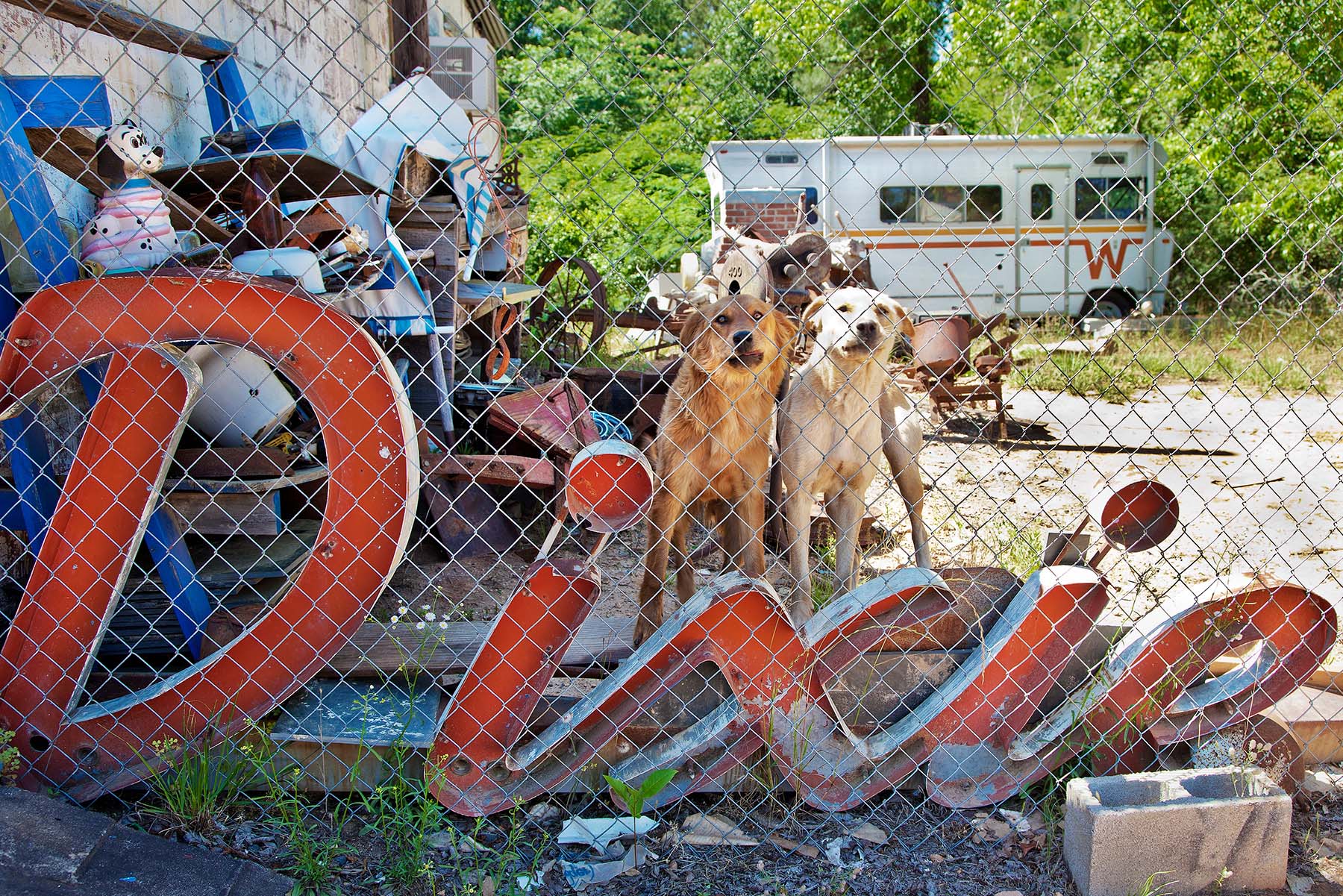We Are More Than Our Past
August 21, 2019
Essayist Michael Ramos reflects on a photograph by Southbound artist Lucinda Bunnen. As part of our Call & Response series in conjunction with Southbound: Photographs of and about the New South, we’ve asked artists, writers, and poets to respond to a photograph of their choice in the form of short written pieces.
By Michael Ramos

Lucinda Bunnen, Dixie Dogs, 2014. Lucinda Bunnen’s work has taken her around the globe, but she continually refocuses her lens on an American South in transition. Her photographs are included in numerous collections, among them the Museum of Modern Art, the Whitney Museum of American Art, and the Smithsonian. ON VIEW AT THE GREGG MUSEUM OF ART & DESIGN AT NC STATE.
This is the real south, isn’t it?
All rust and decay, a fenced-in collection of humid days and sun-baked junk overgrown and unkempt, its glory days long past. You can almost hear the hum of the heat beetle, the growl of a guard dog defending its precious Dixie, oblivious to its disrepair keeping everyone out, even those who don’t want in.
An outsider’s fantasy, a caricature of the south and all it implies. Dismissed in as much time as it takes to snap a photograph, the south captured, and then forgotten.
I, too, am an outsider, southerner by geography not birth. I, too, see the south in images, a collection, a jumble, decrepit and decaying, derisive of Dixie.
But I live here. Pass by here. What if we stop here a while?
What if the dogs, wary from years of passersby throwing rocks at chain link, at junk, at the past, at them allow us to pass, to examine the debris of times long gone? Feel damp tongues and hot breath on our hands, sniffing us out, our intentions. Wagging tails at would-be friends.
Would they lead us to their favorite things? A rusted tractor tire, gritty and rough? A bone amongst the bric-a-brac? Would we trace our fingers over the chalky, faded curves of Dixie and try to understand? Would we find stories of value, of worth, and of love amongst the stories of pain and past?
Would we hear black voices and white voices and the slow soft southern drawl nursed on porch swings and someone somewhere shelling peas say we are more than our past, more than what we seem?
 Michael Ramos is a greenside Navy Iraq vet who is now a temporary lecturer in creative writing at UNC Wilmington, where he received both his BFA and MFA. His work has appeared in The Sun (January 2012) and Fourth Genre, (Fall 2016). His essay in Fourth Genre, “A Long But Incomplete List of Some of the Things You Can’t (Don’t) Talk About,” was named a Notable Essay in Best American Essays 2017.
Michael Ramos is a greenside Navy Iraq vet who is now a temporary lecturer in creative writing at UNC Wilmington, where he received both his BFA and MFA. His work has appeared in The Sun (January 2012) and Fourth Genre, (Fall 2016). His essay in Fourth Genre, “A Long But Incomplete List of Some of the Things You Can’t (Don’t) Talk About,” was named a Notable Essay in Best American Essays 2017.
Southbound: Photographs of and about the New South is presented by the Power Plant Gallery in collaboration with Duke’s Forum for Scholars and Publics and the Gregg Museum of Art & Design at North Carolina State University. In this iteration, guest curator Randall Kenan, author and NC native, organizes the many framed photographs of the exhibition around the twin themes of Flux, on display at the Power Plant Gallery, and Home, on display at the Gregg Museum. The full program of events includes slow tours, film screenings, “Sit + Chat” sessions, and FSP@PPG panel discussions that engage with the issues in and around the works of art and explore the topics, places, and styles of Southbound. Southbound: Photographs of and about the New South was organized by the Halsey Institute of Contemporary Art at the College of Charleston School of the Arts in Charleston, South Carolina, and curated by Mark Long and Mark Sloan. Visit the exhibit online at southboundproject.org.
check us out
on social media